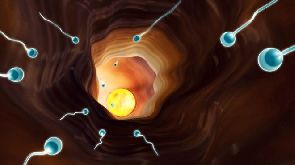How an individual sperm swims, against all the odds, through fluid to reach the fallopian tubes has been revealed – and it’s all about rhythm.
Researchers from the UK and Japan found that the head and tail movements of sperm made patterns similar to the fields that form around magnets.
And these help to propel sperm towards the female egg.
Knowing why some sperm succeed and others fail could help treat male infertility, the researchers said.
More than 50 million sperm embark on the journey to fertilise an egg when a man and woman have sex.
About 10 reach the finish line – but there can only be one winner.
The journey is treacherous, says study author Dr Hermes Gadelha.
“Every time someone tells me they are having a baby, I think it is one of the greatest miracles ever – but no-one realises,” says Dr Gadelha, a lecturer in applied mathematics at the University of York.
How an individual sperm swims, against all the odds, through fluid to reach the fallopian tubes has been revealed – and it’s all about rhythm.
Researchers from the UK and Japan found that the head and tail movements of sperm made patterns similar to the fields that form around magnets.
And these help to propel sperm towards the female egg.
Knowing why some sperm succeed and others fail could help treat male infertility, the researchers said.
More than 50 million sperm embark on the journey to fertilise an egg when a man and woman have sex.
About 10 reach the finish line – but there can only be one winner.
The journey is treacherous, says study author Dr Hermes Gadelha.
“Every time someone tells me they are having a baby, I think it is one of the greatest miracles ever – but no-one realises,” says Dr Gadelha, a lecturer in applied mathematics at the University of York.
When a man has ejaculated, 50 million to 150 million sperm are produced, and these cells immediately start swimming upstream towards a woman’s fallopian tubes.
But it’s not an easy journey – there are lots of hurdles to overcome for the male sex cells, which are just 0.065mm in length.
Only one sperm can penetrate the woman’s egg and fertilise it, so the race is on.
First, they have to survive the vagina, where conditions mean most die. Then they have to avoid dead ends and being trapped before reaching the uterus.
On the way there are marauding white blood cells ready to kill them.
Finally, the remaining sperm arrive at the fallopian tubes, where they are fed.
But has an egg been released at exactly the right time to welcome the winning sperm? If not, the journey has all been in vain.
Source: BBC








